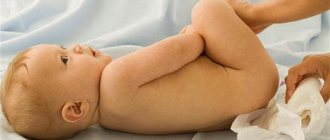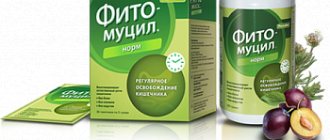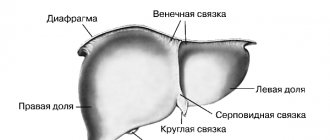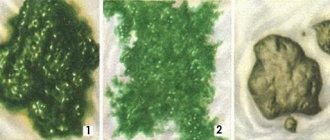The color of a healthy person’s stool normally varies from light brown to dark; a change in shade indicates that some pathological process has begun in the human body. The presence of bilirubin and bile pigments is responsible for the color of feces. Sometimes the color of stool changes due to the characteristics of the food consumed; usually this deviation returns to normal in a day or two. In most cases, orange-colored stool indicates problems with the gastrointestinal tract and digestive system.
Norm and pathology
In normal condition, feces are a small sausage, the size of which can vary from 10 to 20 centimeters. The stool should be uniform brown in color and soft in consistency. There should be no blood or pus in the stool, but mucus in small quantities is considered acceptable. The nature of the feces of different people may differ from normal standards, this is due to a person’s food preferences and depends on the amount of food and water consumed per day.
Deviations from the norm are considered to be the presence of impurities such as blood, pus, and foam in the stool. A sharp change in the color of stool and its consistency may indicate the development of a pathological process in the body.
Treatment
If a patient's orange stool is a symptom of any disease, it is advisable to treat the ailment under the supervision of a gastroenterologist. The choice of medications depends on the nature of the disease, the patient’s age, and possible chronic pathologies.
In case of intoxication
With an increased content of bile in the body, poisoning may develop. The main signs of intoxication caused by stagnation of bile:
- Vomit.
- Orange diarrhea.
- Yellowing of the whites of the eyes.
- Bitter taste in the mouth.
- Decreased appetite.
- General state of weakness.
Therapy includes:
- To relieve symptoms of intoxication, patients are prescribed adsorbents (Smecta, Activated carbon).
- To restore normal functioning of the gallbladder, the patient needs to take Sorbitol and Choleritin.
- Drotaverine, No-shpa, Papaverine will help reduce painful spasms.
An accurate diagnosis is made after receiving the results of tests of urine, blood, and feces. If the doctor detects a lack of bile, the patient is recommended to take Allohol, Flacumin.
For hepatitis
If the cause of orange diarrhea is hepatitis, treatment must be carried out under the supervision of a specialist. The patient is not only prescribed drug therapy, but also a strict diet is recommended: spicy, salty, pickled, and fatty foods are excluded from the diet.
The main treatment for the presence of orange stool in a patient with hepatitis is to stabilize the liver. Appointed:
- Antiviral drugs (for viral hepatitis).
- Hepatoprotectors (Ademetionine, Essentiale-Forte, Rezalut, Karsil).
- Glucose.
- Immunomodulators.
- Vitamins.
Important! Changing the nature of nutrition during hepatitis is of great importance. In patients who take medications but do not follow a diet, indigestion persists longer.
For pancreatitis
A strict diet is also required for this disease, especially in the presence of purulent pancreatitis. The acute form of the pathology requires treatment in a hospital setting. Chronic pancreatitis, accompanied by loose stools, can be treated at home under the supervision of a doctor.
The patient is prescribed:
- Replacement enzymes: Mezim, Creon, Festal, Pancreatin.
- Antispasmodics: Papaverine, No-shpa.
- Enterosorbents for relieving intoxication: Enterosgel, Polysorb.
- Preparations for restoring intestinal microflora: Enterol, Bifidumbacterin, Bifiform.
- Vitamins and microelements.
If the development of illness is caused by E. coli or a viral infection, the patient may be prescribed antibiotics and antimicrobial drugs.
Orange stool is not always a sign of pathology. But in order to exclude possible diseases, you should consult a doctor at the first symptoms of intestinal ailment. Do not self-medicate; many diseases are easier to cure at the very beginning.
Possible causes of orange colored stool
The causes of orange stool in adults may be due to the following factors:
- Excessive consumption of foods that contain large amounts of carotene. These products include: broccoli, carrots, apricot, pumpkin.
- The use of certain medications can also stain stool, in particular, we are talking about a drug such as Rifampicin.
- Diseases of the genitourinary system - cystitis, as well as lung diseases can also cause orange-colored stool.
- Sometimes the reasons for feces turning orange are diseases such as celiac disease, Gilbert's syndrome, and escherichiosis.
- In addition, cirrhosis of the liver, hepatitis, problems with the pancreas and cholelithiasis are the cause of orange-colored stool in adults. In the presence of such pathologies, the patient may also have other signs, namely: pain in the abdominal cavity, the skin and mucous membranes become covered with a yellow tint. The patient has a high body temperature, nausea, vomiting, the stomach is swollen, and the appetite almost completely disappears.
Orange stool due to changes in diet or use of medications
The chair is a “mirror” of the gastrointestinal tract
“Like the table, so is the chair,” gastroenterologists joke somewhat rudely. Orange-colored stool should not be considered a pathological manifestation and treatment should not be prescribed if a person’s diet includes a large amount of foods containing beta-carotene. In addition to carrots, which gave the name to this pigment (“carota” in Latin - carrot), a lot of it is found in pumpkin, sweet potatoes, cauliflower, herbs, lettuce, sea buckthorn oil, and spinach.
Beta-carotene is not completely absorbed, approximately 20-40%, because it has a fibrous structure. In the body, after going through a series of complex chemical reactions, it is synthesized into vitamin A. The intensity of beta-carotene absorption depends on the concentration of bile in the gastrointestinal tract; children, due to their age, absorb it less than adults. The remaining 60-80% leaves the body naturally, turning the stool orange.
A synthetic oil solution of vitamin A, if its daily requirement is exceeded, can have a similar effect on the color of stool. Some multivitamins have the same effect if the dosage is not followed. In parallel with the change in the color of the stool, the feet, palms, and whites of the eyes may turn yellow. Orange stool is a side effect of the antibacterial drug rifampicin, used in the treatment of tuberculosis, gonorrhea, leprosy, and rabies. This is due to its effect on liver function and the composition of the blood formula. This effect is most pronounced at the beginning of use of the drug.
After assessing the composition of your menu and the dosage of vitamin preparations you take, you can temporarily stop consuming foods with beta-carotene. If the color of the stool does not change within 2-3 days, the cause should be sought in another area of medicine.
Causes in children
Unlike adults, it is quite common to see orange colored stool in children, and in most cases this is not a deviation from the norm. Orange-colored feces in a baby may be the result of a regular banana eaten the day before. In this case, it does not matter whether the child ate this banana himself or received it from the mother along with breast milk. Older children often eat and drink food products to which dye is added, such as candy, juices and drinks.
Eating low-quality ingredients can cause your baby to have bright orange-colored stool with a liquid consistency, which indicates disorders of the child’s digestive system.
The presence of pus and blood in the stool indicates the development of dysentery or more serious pathologies. In this case, you should immediately consult a doctor.
Orange stool color in infants
The color of feces in a baby receiving only mother's milk varies from light yellow to bright orange and may even be greenish. The color of feces depends on the diet of the nursing mother, the frequency of feeding, and whether the woman is taking any medications. Normally, newborn poop is mushy and may have large fractions. Artificially produced feces are more formed and may even be brown in color.
In complementary-fed babies, the color of their stool changes to bright orange depending on the foods they eat. Pumpkin and carrots, as well as other vegetables containing dyes, strongly color feces, since they are not completely digested in children's immature intestines.
A pathology is considered to be a change in color when the unnatural shade of stool persists for several days, does not appear after eating food rich in carotenes, and also in cases where the child has loose stool.
Pathological orange coloration of feces in a baby is caused by:
- Liver diseases . With these ailments, the color of the baby's stool changes, diarrhea appears, the child becomes capricious, sleeps poorly, and refuses food.
- Cystitis . Orange stool appears in advanced cases when the child’s kidneys cannot cope with filtering toxins entering the body.
- Inflammatory processes in the intestines. Liquid orange stool in a newborn can be a sign of gastritis, dysbiosis, infection, or food allergies.
- Impaired flow of bile . A common cause of orange stool in infants. Due to the fact that bile is not processed to the required extent by gastric juice, it enters the stool unchanged, giving it a yellowish-orange color.
Important! If blood appears in the stool in children or adults, it is imperative to seek medical help. Urgent assistance is also required for expectant mothers who have been suffering from diarrhea for more than three days.
Diagnostic measures
Diagnosis of orange-colored stool includes a number of the following measures:
- As with any other disease, to determine the cause of orange-colored stool, it is necessary to conduct a general analysis of stool and urine.
- Advanced stool analysis - coprogram.
- Genetic testing for diseases such as Gilbert's syndrome and celiac disease.
- An ultrasound examination will help to see the condition of the liver and pancreas, as well as establish an accurate diagnosis.
In general, it is not difficult to establish the reason why the stool is orange; the most important thing in this case is to promptly contact a specialist who can accurately diagnose and prescribe appropriate treatment.
Other reasons
Experts do not rule out other reasons for changes in stool color that are indirectly related to digestive disorders. The chair turns orange when:
- Infections and intoxication associated with the rapid growth of pathogens.
- Cystic formations in the kidneys, liver, pancreas.
- Other kidney diseases accompanied by impaired removal of toxins from the body
- Gallbladder diseases.
With these diseases, stool may change in shades: from light milky to brick red. There is also a significant dilution of the stool, and with infections, the stool generally becomes watery and foamy.
Decoding the analysis in adults
Stool analysis helps determine the presence or absence of problems in the gastrointestinal tract. And with a chemical analysis, the presence of salts and protein is determined, acidity, mucus and some other indicators necessary to determine an accurate diagnosis are established.
- Soluble protein. The presence of this substance in the feces indicates that a malfunction has begun in the digestive system, since normally there should be no protein in the feces.
- Starch. This substance, present in feces, indicates a deviation from the norm, since starch must be completely broken down during the digestion of food.
- Muscle fibers. In a completely healthy person, fibers are present in the feces in a modified form, but if they are in an unchanged form, then this indicates a malfunction of the pancreas.
- Leukocytes. In a normal state, a person should not have white blood cells. Their detection and increased number indicate that the patient is developing pathologies of the gastrointestinal tract.
- Connective tissue fibers. This component is the remains of food of animal origin found in feces during defecation. The presence of such fibers indicates that the patient has low acidity, gastritis or pancreatitis.
Features of nutrition and medications
Bilirubin gives stool its color. Depending on your diet and when taking certain medications, bilirubin changes its color, which means it colors the stool in different shades. Yellow feces are typical for people who adhere to a strictly dairy diet. Light brown stool is noted by people who follow a strictly plant-based diet. And orange poop is often found in carrot lovers. This vegetable contains a pigment that, when released into the intestines, turns feces orange.
Interesting: Yellow feces are observed in infants due to increased fermentation in the intestines. This color of stool is normal for them, and orange stool in a baby indicates indigestion, which is associated with an incorrectly selected formula or intolerance to breast milk.
Some medications change the color of stool because they affect liver function. Orange-colored feces may appear when taking antibiotics, cytostatics, oral contraceptives, anti-tuberculosis drugs, and anti-epileptic drugs.
Article on the topic: Carsil tablets in the treatment of liver diseases
Decoding the analysis in children
Decoding a coprogram in children is somewhat different from in adults. One of the important indicators is the volume of feces. Thus, an excessively large or small amount of feces indicates that the child is experiencing a disturbance in the functioning of the gastrointestinal tract.
The consistency of the feces is equally important. Pasty stools may indicate colitis, and liquid ones may indicate that intestinal secretion is greatly increased.
The change in the color shade of feces in infants depends on what diet the nursing mother is on. In some cases, stool may change color as evidence that the baby has begun to have intestinal problems, so young mothers during lactation should follow a strict diet prescribed by a doctor.
Orange stool in pregnant women
A change in the color of feces in pregnant women is observed due to disturbances in the functioning of the gastrointestinal tract. Already at the end of the first trimester of pregnancy, the growing uterus begins to put pressure on nearby organs. The passage of digested food through the intestines is gradually disrupted, which leads to frequent constipation and sometimes diarrhea.
Also, the cause of orange diarrhea is stagnation of bile, provoked by the appearance of stones in the ducts, gall bladder, or pressure of the fetus on the digestive organs.
When should you see a doctor?
If the orange-colored feces remain for a day or two, and, in addition to the change in the color of the feces, there are no more impurities, then this is not a cause for concern.
If this condition lasts more than two days, then in this case you should consult a doctor. The presence of blood or pus in the stool also requires immediate contact with a specialist.
Disorders of the liver and pancreas
Pathologies of the pancreas, accompanied by impaired enzyme production, lead to orange diarrhea in a person.
Changes in the color of feces are caused by the following diseases:
- Pancreatitis . With pancreatitis, the pancreas does not produce enough enzymes. This leads to disruption of the digestive processes and the appearance of feces of an unnatural color, diluting the stool in an adult, staining the feces orange or yellow
- Cancer . With this pathology, the patient’s stool is unstable, and there is either constipation or diarrhea. Stool color: from red-orange to colorless.
Also, liver diseases accompanied by impaired outflow or processing of bile can cause changes in stool color. Liquid orange stool is one of the symptoms of the following pathologies:
- Acute and chronic hepatitis . A feeling of heaviness in the right side of the abdomen, stabbing pain and frequent diarrhea are symptoms of the disease.
- Blockage of the biliary tract . The cause of impaired bile secretion may be stones, sand in the ducts, or inflammatory processes.
- Toxic reactions to taking medications, poisoning . With these pathologies, the number of red blood cells decreases, as they disintegrate and there is an increase in leukocytes in the blood.
Due to the increased breakdown of red blood cells, the level of free bilirubin in the blood increases in a person. An increase in the level of direct bilirubin in the blood leads to the development of jaundice. In this case, bile pigments, the appearance of which is associated with a violation of the processing of bilirubin by the liver, can be observed in both urine and feces.
Important! If a child’s orange liquid stool does not depend on nutrition, the baby complains of severe abdominal pain or cries for no reason, parents should be wary. Since such signs may indicate a problem with the liver or pancreas, you should consult a doctor as soon as possible.
Treatment of the causes of orange stool
If the stool begins to turn orange, the necessary treatment is prescribed by a gastroenterologist in accordance with what caused the changes.
If, during diagnosis, a large number of red and white blood cells are found in the patient, the doctor prescribes anti-inflammatory drugs, as this is the cause of the development of the inflammatory process in the body.
An infectious disease detected during diagnosis requires immediate hospitalization of the patient. The patient is first given medications that normalize the water-salt balance and intestinal microflora, and only after that the doctor prescribes medications that eliminate the inflammatory process, as well as rid the body of pathogenic bacteria. In addition, the patient is recommended a course of restorative therapy.
If gallstones are found in a patient with orange-colored stool, it is recommended to remove them through surgery.
It is important to note that if the color of stool changes in children or adults, you should not wait for time, but should immediately consult a doctor. Except for those moments when there is an exact certainty that the coloring of the feces was caused by some food product from the diet, in this case there is no need to worry, since the situation will normalize by itself.
Orange stool for infectious diseases
Orange stool is a symptom of escherichiosis
Most often, orange stool is a symptom of an infectious disease such as escherichiosis. It is caused by pathogenic microorganisms. Sources of infection can be both patients with escherichiosis and hidden carriers of the bacilli. Characteristic symptoms of infection:
- Watery orange stools, very frequent (up to 20 times a day)
- Vomiting or regurgitation
- Pain and rumbling in the intestines, bloated stomach
- Increased body temperature
- Increasing symptoms of dehydration
Pathogens enter the body through insufficiently heat-treated meat and dairy products and failure to comply with personal hygiene rules. The body becomes especially susceptible to changes in climate and diet. Traveler's Diarrhea can ruin any trip if not treated immediately. Depending on the type of E. coli, Escherichiosis takes different forms. With the enterotoxigenic form, characterized by the absence of fever and liquid orange stool without its inherent odor, recovery occurs spontaneously, with virtually no treatment.
In the enteroinvasive form with pain in the lower abdomen, a sharp increase in temperature, frequent mucous stools, muscle pain, a state of weakness can last 2-3 days. Consultation with an infectious disease specialist and treatment aimed at relieving symptoms of intoxication are required. The most dangerous form of escherichiosis is considered to be enterohemorrhagic, manifested by severe pain and spasms in the lower part of the large intestine, loose orange stools with blood clots. This form is characterized by the absence of fever and symptoms of intoxication, but its consequences can be severe kidney damage, a sharp decrease in platelets in the blood, fraught with heavy bleeding.
Orange stool in combination with signs of an intestinal infection may be a manifestation of escherichiosis, an intestinal infection that requires qualified treatment to avoid serious consequences.











